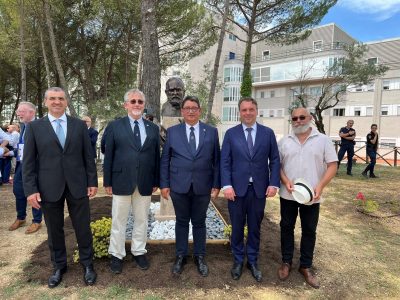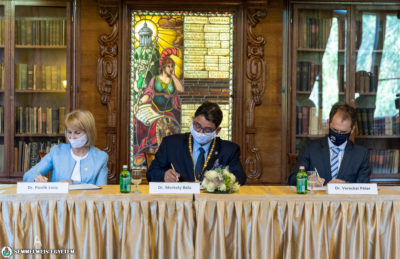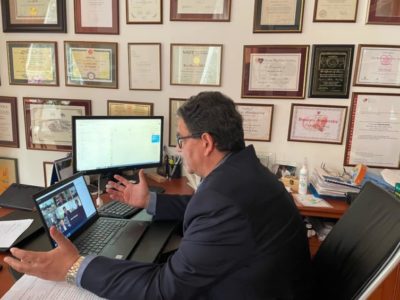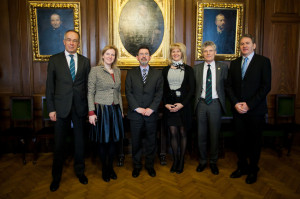 Professor Ágoston Szél, rector of Semmelweis University and Professor Mária Judit Molnár, vice-rector for scientific affairs welcomed the delegation from the university of the North German city of Lübeck. The delegation’s programme started with a meeting where the leaders of the two universities discussed matters related to the structure and management of the institutions. Rector Ágoston Szél pointed out that the visit of the delegation of the University of Lübeck was an excellent opportunity to strengthen and develop the relations in the areas of both education and research. “We consider our German relations very important and we are also proud of them”. Both sides emphasised the importance of the individual collaborations between researchers in establishing and maintaining an international cooperation.
Professor Ágoston Szél, rector of Semmelweis University and Professor Mária Judit Molnár, vice-rector for scientific affairs welcomed the delegation from the university of the North German city of Lübeck. The delegation’s programme started with a meeting where the leaders of the two universities discussed matters related to the structure and management of the institutions. Rector Ágoston Szél pointed out that the visit of the delegation of the University of Lübeck was an excellent opportunity to strengthen and develop the relations in the areas of both education and research. “We consider our German relations very important and we are also proud of them”. Both sides emphasised the importance of the individual collaborations between researchers in establishing and maintaining an international cooperation.
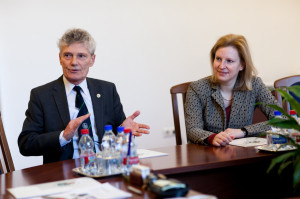 The programme continued with professional visits after the meeting was concluded in the Rector’s office. Dr. Christine Klein, director of the Department of Neurogenetics at the University of Lübeck, visited Semmelweis University’s Department of Genomics and Rare Diseases which is directed by Dr. Mária Molnár Judit. Dr. Peter Dominiak, president of the University of Lübeck was welcomed by Dr. Miklós Kellermayer, director of the Department of Biophysics and Radiation Biology at the Centre of Theoretical Medicine.
The programme continued with professional visits after the meeting was concluded in the Rector’s office. Dr. Christine Klein, director of the Department of Neurogenetics at the University of Lübeck, visited Semmelweis University’s Department of Genomics and Rare Diseases which is directed by Dr. Mária Molnár Judit. Dr. Peter Dominiak, president of the University of Lübeck was welcomed by Dr. Miklós Kellermayer, director of the Department of Biophysics and Radiation Biology at the Centre of Theoretical Medicine.
The Research Salon’s programme was organised in honour of the delegation from Lübeck which was hosted by Dr. Péter Bucsky, the rector’s representative of Asklepios Campus Hamburg. The former professor of the University of Lübeck played an important role in establishing and developing the relations between the two universities and also in identifying those fields where – based on reciprocity – cooperation may be launched.
[pullquote]The cooperation offers a lot more than what we currently make use of; we could create more student and teacher exchange programmes, therefore the renewal of these types of cooperation is our priority now[/pullquote]The Researchers’ Salon was opened by Rector Ágoston Szél who underlined that the visit was an excellent opportunity to revitalise and develop relations between the two institutions. The cooperation offers a lot more than what we currently make use of; we could create more student and teacher exchange programmes, therefore the renewal of these types of cooperation is our priority now – said Rector Szél.
Dr. Péter Pál Bucsky reminded the audience that the president of the University of Lübeck visited Semmelweis University for the first time in 2006. On that occasion he and former rector Dr. Tivadar Tulassay signed a memorandum of understanding. In 2008 the rector of Semmelweis University visited Lübeck; however, no high-level visit has taken place between the institutions until now.
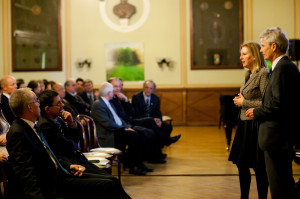 Dr. Peter Dominiak, as the first speaker of the Salon, presented the University of Lübeck which was founded in 1964; it currently has 5000 employees and 3500 students. The German university is among the top three universities in the ranking of the Federal Ministry of Economics & Technology’s EXIST programme, a competition that focuses on start-up institutions. At the outset the university’s educational and research activities only took place in the field of medicine; however, today there are faculties of information technologies, natural sciences and engineering as well while degree programmes in psychology were launched recently. The Biomedical Engineering and Infection Biology Programmes are taught in English as well.
Dr. Peter Dominiak, as the first speaker of the Salon, presented the University of Lübeck which was founded in 1964; it currently has 5000 employees and 3500 students. The German university is among the top three universities in the ranking of the Federal Ministry of Economics & Technology’s EXIST programme, a competition that focuses on start-up institutions. At the outset the university’s educational and research activities only took place in the field of medicine; however, today there are faculties of information technologies, natural sciences and engineering as well while degree programmes in psychology were launched recently. The Biomedical Engineering and Infection Biology Programmes are taught in English as well.
The presentation revealed that the three key research areas of the University of Lübeck are medicine, life sciences and IT. All these contribute to the novel field of biomedical technology which is currently under development.
Dr. Peter Dominiak also drew attention to the fact that a new research building – the Centre for Brain Behaviour and Metabolism – will be finished at the end of the year. The Centre for Infection and Inflammation was established in 2011 and the BioMedTec Science Campus was founded in 2012.
The president emphasised at the end of the presentation that Lübeck is not only known as the home town of Thomas Mann and as a World Heritage, but also as a city of science.
Following that presentation Dr. Christine Klein, section head at the Neurology Institute of the University of Lübeck, held a presentation on the genetics of movement disorders. She also touched upon how the results of basic research can be utilised in clinical practice based on translational medicine.
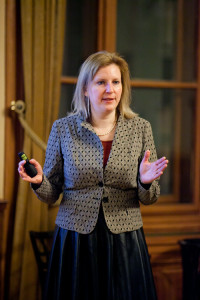 She introduced the work of the relatively young Section of Clinical and Molecular Neurogenetics. The Section primarily focuses on rare neurological diseases and – more precisely – on hereditary forms of movement disorders, such as Parkinson’s disease or dystonia. Their main objective is to identify the genetic factors that are the primary contributors to the formation of the disorders. Dr. Christine Klein underlined that their team is interdisciplinary, in other words movement disorder specialists and basic researchers are part of the team as well as research technologists, clinicians and ancillary staff. Therefore the research has a translational approach; the connection is strong between the research activities and the sickbed.
She introduced the work of the relatively young Section of Clinical and Molecular Neurogenetics. The Section primarily focuses on rare neurological diseases and – more precisely – on hereditary forms of movement disorders, such as Parkinson’s disease or dystonia. Their main objective is to identify the genetic factors that are the primary contributors to the formation of the disorders. Dr. Christine Klein underlined that their team is interdisciplinary, in other words movement disorder specialists and basic researchers are part of the team as well as research technologists, clinicians and ancillary staff. Therefore the research has a translational approach; the connection is strong between the research activities and the sickbed.
Dr. Klein also touched upon a research article published last year the goal of which was to pinpoint the gene that causes the DYT4 type dystonia. The results of the analysis – conducted with an Australian family – showed that the TUBB4 gene’s mutation plays a role in the disorder’s appearance.
The researchers of the Section of Clinical and Molecular Neurogenetics also participate in the research of new therapies. They consider it important that understanding the human genome not only provides opportunity to identify the genes causing illnesses, but also informs us regarding the progression of the disease and the optimal choices of treatment.
Pálma Dobozi
Photos: Attila Kovács – Semmelweis University
Translated by Bonifac Makkai
